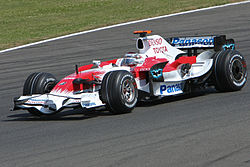 Jarno Trulli driving the TF108 at the 2008 British Grand Prix | |||||||||||
| Category | Formula One | ||||||||||
|---|---|---|---|---|---|---|---|---|---|---|---|
| Constructor | Toyota | ||||||||||
| Designers | Yoshiaki Kinoshita (Executive Vice President - Technical) Noritoshi Arai (Director Technical Coordination) Pascal Vasselon (Senior General Manager Chassis) John Litjens (Chief Designer) David Neilsen (Chief Designer - Car Concept) Mark Gillan (Head of Aerodynamics) Jason Somerville (Deputy Head of Aerodynamics) Luca Marmorini (Engine Director) Hiroshi Yajima (Chief Designer, Engine) | ||||||||||
| Predecessor | TF107 | ||||||||||
| Successor | TF109 | ||||||||||
| Technical specifications | |||||||||||
| Chassis | Moulded carbon fibre and honeycomb construction monocoque | ||||||||||
| Suspension (front) | Carbon-fibre double wishbone arrangement, with carbon-fibre track rod and pushrod | ||||||||||
| Suspension (rear) | Carbon-fibre double wishbone arrangement, with carbon-fibre track rod and pushrod | ||||||||||
| Engine | Toyota RVX-08 2398 cc V8 19,000 RPM Limited naturally-aspirated mid-engine | ||||||||||
| Transmission | Toyota/WilliamsF1/Xtrac collaboration 7-speed unit plus reverse | ||||||||||
| Power | 750 hp @ 19,000 rpm [1] | ||||||||||
| Fuel | Esso | ||||||||||
| Lubricants | Esso | ||||||||||
| Brakes | Brembo callipers and master cylinders, Hitco material (carbon/carbon) | ||||||||||
| Tyres | Bridgestone Potenza BBS forged magnesium | ||||||||||
| Competition history | |||||||||||
| Notable entrants | Panasonic Toyota Racing | ||||||||||
| Notable drivers | 11. 12. | ||||||||||
| Debut | 2008 Australian Grand Prix | ||||||||||
| Last event | 2008 Brazilian Grand Prix | ||||||||||
| |||||||||||
The Toyota TF108 was a Formula One car designed and engineered by Toyota to compete in the 2008 Formula One season. The chassis was designed by Pascal Vasselon, John Litjens and Mark Gillan with the engine being designed by Luca Marmorini and Noritoshi Arai overseeing the entire project. The car's best finish was second in the Hungarian Grand Prix, driven by Timo Glock.

